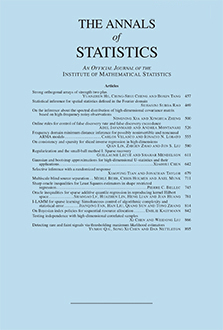Abstract
Suppose that the mean $\tau$ of a vector of Poisson variates is known to lie in a bounded domain $T$ in $\lbrack 0,\infty)^p$. How much does this a priori information increase precision of estimation of $\tau$? Using error measure $\sum_i(\hat\tau_i - \tau_i)^2/\tau_i$ and minimax risk $\rho(T)$, we give analytical and numerical results for small intervals when $p = 1$. Usually, however, approximations are needed. If $T$ is "rectangularly convex" at 0, there exist linear estimators with risk at most 1.26$\rho(T)$. For general $T, \rho(T) \geq p^2/(p + \lambda(\Omega))$, where $\lambda(\Omega)$ is the principal eigenvalue of the Laplace operator on the polydisc transform $\Omega = \Omega(T)$, a domain in twice-$p$-dimensional space. The bound is asymptotically sharp: $\rho(mT) = p - \lambda(\Omega)/m + o(m^{-1})$. Explicit forms are given for $T$ a simplex or a hyperrectangle. We explore the curious parallel of the results for $T$ with those for a Gaussian vector of double the dimension lying in $\Omega$.
Citation
Iain M. Johnstone. K. Brenda MacGibbon. "Minimax Estimation of a Constrained Poisson Vector." Ann. Statist. 20 (2) 807 - 831, June, 1992. https://doi.org/10.1214/aos/1176348658
Information





